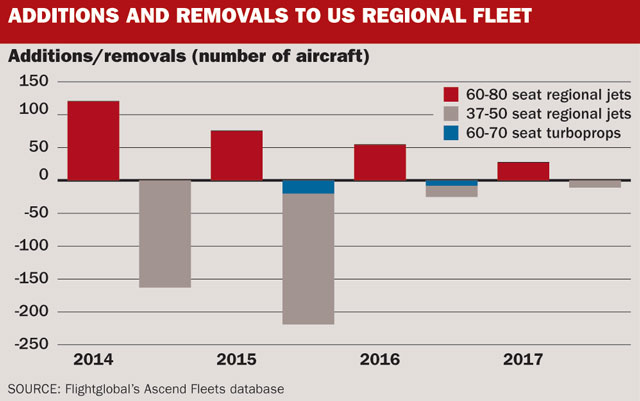Michael Lapson, senior analyst in the New York office of Flightglobal’s Ascend consultancy, examines the impact of revised scope clauses in the US market
Pilot scope clauses have been an important part of the US airline landscape since the 1980s and '90s, when mainline pilots sought to protect their jobs from outsourcing to smaller aircraft at regional airlines with much lower pilot pay scales by restricting the size and number of aircraft that could be outsourced.
But there has been a major change in the market since the onset of the recession, with airline mergers and the re-negotiation of scope clauses making this a good time to review current positions and future possible directions.
The importance of scope clauses can be measured in the number of aircraft designs that were designed specifically to meet the limitations on seat counts. Initially, fleets were built around the 50-seat Bombardier CRJ and Embraer ERJ-145, but then the 37-seat ERJ-135 and 44-seat ERJ-140 were developed for American Airlines.
These small, 37- to 50-seat regional jets enabled hub development in the 1990s and early 2000s, but higher fuel prices since 2009 have adjusted their economics. This, and the recent mergers, have led to the US major airlines wanting to reduce this fleet and move to higher capacity aircraft with better unit costs.
In the past decade, the US majors have negotiated concessions, sometimes taking advantage of Chapter 11 bankruptcy protection, allowing them to operate limited numbers of larger regional jets with more than 50 seats. Major changes have occurred since 2011, with each of the three major US airlines re-negotiating their scope clauses to focus on much larger fleets of 76-seat aircraft with dual class cabins, complemented by additional mainline aircraft – for example, Delta Air Lines’ “new” fleet of Boeing 717s acquired from Southwest Airlines.
The new scope clauses regard turboprops in the same way as regional jets (previously, fleets of turboprops were not generally limited), and very few are now left feeding US majors. Most US turboprops are now flown by independent operators at their own risk. The decision by United Airlines to replace its Bombardier Dash 8 Q400s with Embraer E175s is a consequence of the new scope agreement.
After the rise in fuel prices, the 37- to 44-seat ERJ-135/140s were the first to be phased out, while the current focus is on reducing CRJ and ERJ-145 fleets, with the 1,350-strong fleet a decade ago declining to less than 920 at present.
In the next two years, this trend is set to continue, with more than 250 more 50-seaters set to be phased out. Some 120 76-seaters will have been added to the fleet in 2014 and more than 140 are already on order for delivery in 2016. American Airlines, Delta and United are all adding E175s and the first two are also adding CRJ900s, while Republic and SkyWest have ordered their own E175s for contract flying for American and United.
The accompanying chart shows Ascend’s projections of additions and removals from the US regional fleet, based on the analysis of airline financial statements, regional capacity contracts and order backlogs.

It could be that the next round of scope clauses will see some relaxation spurred by changing rules for regional pilot training. New rules that took effect in August 2013 now require regional airline pilots to have the same amount of flight training and experience as mainline pilots. For the first time, regional airlines and mainline carriers are in direct competition to hire each new pilot.
Meanwhile, over the next eight years, it is predicted that 40% of the pilots currently flying at mainline carriers will retire and will need to be replaced by thousands of less senior pilots. These factors, and the strong finances at US airlines, will create upward pressure on wages at regional airlines, and could lead to new mainline pilot agreements with wage increases in return for more fleet flexibility.
There is already provision in current agreements to allow mainline pilots to fly 100- to 120-seat aircraft – for example, the United Airlines agreement specifies salaries for E190/195 aircraft at levels consistent on a $/seat basis with the Boeing 737-800 and Airbus A320.
The latest new technology regional jet manufacturers appear to be expecting further scope relaxation in the next round of negotiations in 2015-2018. The new technology regional jets in development are significantly heavier than previous aircraft, and as a result of this, neither the Mitsubishi MRJ90 nor the Embraer E175-E2 meet the 39t (86,000lb) maximum take-off weight restrictions of existing scope clauses.
Therefore, there will be a lot of interested parties that will want to see the restriction raised, presumably in return for no increase in the size of aircraft allowed – or increased wages. Given the fact that airlines have already ordered a significant number of E175-E2s and MRJ90s, we do expect them to become key players in the US regional fleets in the 2020s.
Source: Cirium Dashboard























